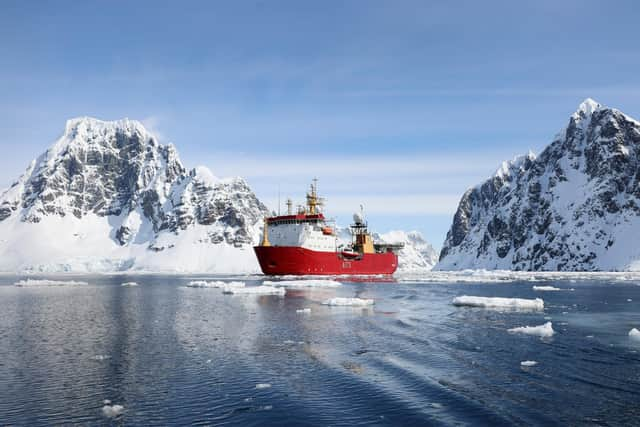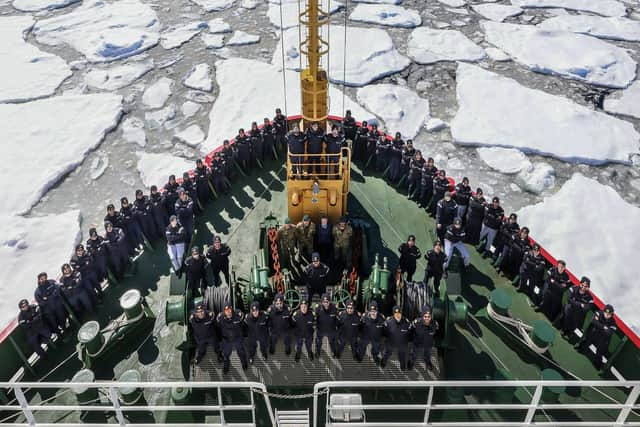Royal Navy Ice Ship HMS Protector traverses 'lively' conditions to reveal impact of global warming in Antarctica
and live on Freeview channel 276
The navy’s only Antarctic research ship completed its first work package under Operation Austral.
HMS Protector is on a five-year task in Antarctica, supporting international research international research into wildlife, the changing climate and shifting waters in the area.
Advertisement
Hide AdAdvertisement
Hide AdCrew are upholding UK’s long-standing commitment to the region.


The icebreaker has three concerted ‘work periods’ planned around the Antarctic Peninsula before autumn.
Weather after this period would stop the ship from moving safely around numerous bases and through icy waters.
HMS Protector’s first task in the region, through Christmas to the beginning of 2022, was to support research into penguin populations in the South Sandwich Islands.


Advertisement
Hide AdAdvertisement
Hide AdThe survey ship continued her scientific mission while traversing some of the bleakest, most remote islands on the planet.
Devonport-based HMS Protector was tasked with charting some of the waters around the Cook Islands and Southern Thule – some of which haven’t been updated in over a century.
Unfavourable sea conditions and grounded icebergs forced the ship to shelter inside a caldera – the hollowed-out innards of a volcano – for two days.
While there, an uncharted portion on the west coast of Cook was surveyed, which is the eastern part of the two islands forming the caldera.
Advertisement
Hide AdAdvertisement
Hide AdHer survey motor boats charted the east coast of Thule under the lee of glacial cliffs.
HMS Protector then crossed over 600 miles of the Scotia Sea, which crew described as ‘lively.’
They then set to work in the South Orkneys, an uninhabited British archipelago on the fringe of Antarctica.
Conditions in the area have changed as a result of rising temperatures. Sunshine Glacier on Coronation Island has moved three-quarters of a mile in 30 years.
Advertisement
Hide AdAdvertisement
Hide AdThe glacier, roughly 750 miles from the Falklands and 350 from the Antarctic Peninsula, shifted due to global warming.
Subsequently, uncharted waters – dubbed Iceberg Bay – were revealed which Protector surveyed.
The waters off the neighbouring island of Signy were also scanned – with the crew finding a dangerous shoal on the approach to Cummings Cove and perilous rock in Borge Bay.
Commanding Officer of HMS Protector, Mark Wood, led a team which landed on Signy to check the research station.
Advertisement
Hide AdAdvertisement
Hide AdIt is only occupied in the austral summer, and sailors found no damage had been caused to the base by harsh weather over winter.
The station was safe for scientists to move in and study the island’s penguin population, petrels and rich biodiversity.
HMS Protector also called at Base Y on Horseshoe Island, the large BAS facility at Rothera, and the Argentinian research base at San Martin.
Sailors spent a rough Christmas at Rothera, as Covid precautions meant the sailors couldn’t mix with scientists and join in festivities.
Advertisement
Hide AdAdvertisement
Hide AdLater in the season, 70 sailors and Royal Marines did manage to capture photographs of the stunning scenery in the Lemaire Channel.
Difficult conditions continued, as despite the near perfect weather, the ship found navigating the strait tricky.
Significant concentrations of ice and icebergs almost completely blocked the southern entrance of the strait.
After the passage, second-in-command Commander Thomas Boeckx led visits to Spanish and Argentine bases.
Advertisement
Hide AdAdvertisement
Hide AdFinally, HMS Protector headed back to the Falkland Islands to restock and supply.
A message from the Editor, Mark Waldron
Subscribe here for unlimited access to all our coverage, including Pompey, for just 26p a day.
Comment Guidelines
National World encourages reader discussion on our stories. User feedback, insights and back-and-forth exchanges add a rich layer of context to reporting. Please review our Community Guidelines before commenting.
